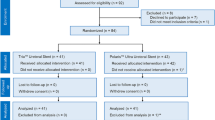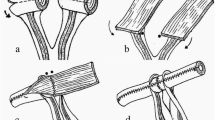Abstract
The aim of the study was to determine the optimal stent size and stenting duration following retrograde endoureterotomy of experimental ureteral strictures. Twenty healthy Large White female pigs were randomly divided into four groups, depending on stent size (7F vs 14F) and stenting duration (3 weeks vs 6 weeks). Three additional pigs were used as the control group. The internal ureteral diameter was measured 2 cm below the lower pole of the right kidney. Histopathological changes of the urinary tract, ultrasonographic and fluoroscopic studies, urine culture, and serum urea and creatine levels were analyzed during the different phases of the study. The study was divided into three phases. Phase I included premodel documentation of the normal urinary tract and laparoscopic ureteral stricture creation. During the second phase 1 month later, the diagnosis and endourologic treatment of strictures were performed. Phase III began 4 weeks after stent removal; follow-up imaging studies and postmortem evaluation of all animals were performed. Ureteral strictures developed in all animals 4 weeks after model creation. Results from ureteral diameter measurements and pathological studies revealed no statistically significant intergroup differences. However, prevalence of urinary infection proved to be directly related to stent size (14F) and permanence (6 weeks). The chi square results suggest a statistically significant relationship between the urinary tract infection and recurrent strictures (α = 0.046). We recommend the use of 7F stents for a period of 3 weeks or less, as these are more easily positioned and result in the reduction of secondary side effects (lower infection rate, less intramural ureteral lesions). A significant relationship between urinary tract infection and stricture recurrence was found in this experimental study.





Similar content being viewed by others
References
Kaskarelis IS, Papadaki MG, Malliaraki NE, et al. (2001) Complications of percutaneous nephrostomy, percutaneous insertion of ureteral endoprosthesis, and replacement procedures. Cardiovasc Intervent Radiol 24(4):224–228
Andreoni CR, Lin HK, Olweny E, et al. (2004) Comprehensive evaluation of ureteral healing after electrosurgical endopyelotomy in a porcine model: original report and review of the literature. J Urol 171(2):859–869
Kerbl K, Chandhoke PS, Figenshau RS, et al. (1993) Effect of stent duration on ureteral healing following endoureterotomy in an animal model. J Urol 150(4):1302–1305
Mandhani A, Kapoor R, Zaman W, et al. (2003) Is a 2-week duration sufficient for stenting in endopyelotomy? J Urol 169(3):886–896
Davis DM, Strong GH, Drake WM (1948) Intubated ureterotomy: experimental work and clinical results. J Urol 59:851–863
Auge BK, Preminger GM (2002) Ureteral stents and their use in endourology. Curr Opin Urol 12(3):217–222
Danuser H, Hochreiter WW, Ackermann DK, et al (2001) Influence of stent size on the success of antegrade endopyelotomy for primary ureteropelvic junction obstruction: results of 2 consecutive series. J Urol 166:902–909
Kumar R, Kapoor R, Mandhani A, et al. (1999) Optimum duration of splinting after endopyelotomy. J Endourol 13(2):89–92
Nakada SY, Soble JJ, Gardner SM, et al. (1996) Comparison of Acucise endopyelotomy and endoballoon rupture for management of secondary proximal ureteral stricture in the porcine model. J Endourol 10(4):311–318
Cantasdemir M, Kantarci F, Numan F, et al. (2003) Renal transplant ureteral stenosis: treatment by self-expanding metallic stent. Cardiovasc Intervent Radiol 26(1):85–87
Pearle MS, Moon YT, Endicott RC, et al. (1994) Comparison of retrograde endo-pyelotomy and endo-balloon rupture of the ureteropelvic junction in a porcine model. J Urol 152(6):2232–2239
Abdel-Hakim AM (1987) Endopyelotomy for ureteropelvic junction obstruction: is long-term stenting mandatory? J Endourol 1(4):265–268
Anidjar M, Meria P, Cochand-Priollet B, et al. (1997) Evaluation of optimal stent size after antegrade endopyelotomy: an experimental study in the porcine model. Eur Urol 32(2):245–252
Moon YT, Kerbl K, Pearle MS, et al. (1995) Evaluation of optimal stent size after endourologic incision of ureteral strictures. J Endourol 9(1):15–22
Soria F, Sánchez FM, Ezquerra LJ, et al. (2002) Diagnosis and follow up with endoluminal ultrasound in the endourologic treatment of experimental ureteral stenosis. Acta Urol Esp 26(3):174–181
Kehinde EO, Rotimi VO, Al-Awadi KA, et al. (2002) Factors predisposing to urinary tract infection after J ureteral stent insertion. J Urol 167(3):1334–1337
Chew BH, Knudsen BE, Denstedt JD (2004) The use of stents in contemporary urology. Curr Opin Urol 14(2):111–115
Selmy GI, Hassouna MM, Begin LR, et al. (1993) Long term effects of ureteric stent after ureteric dilation. J Urol 150(6):1984–1989
Acknowledgments:
The authors are especially grateful to Beatriz Loscertales, Idoia Díaz-Güemes, Sandra Bravo, and Azucena Santos for their excellent assistance in this study. This work was funded by the Consejería Educación, Ciencia y Tecnología 2PR02A066 (Junta de Extremadura, Spain).
Author information
Authors and Affiliations
Corresponding author
Rights and permissions
About this article
Cite this article
Soria, F., Sánchez, F.M., Sun, F. et al. Comparative Study of Ureteral Stents Following Endoureterotomy in the Porcine Model: 3 vs 6 Weeks and 7F vs 14F. Cardiovasc Intervent Radiol 28, 773–778 (2005). https://doi.org/10.1007/s00270-004-0266-3
Published:
Issue Date:
DOI: https://doi.org/10.1007/s00270-004-0266-3




